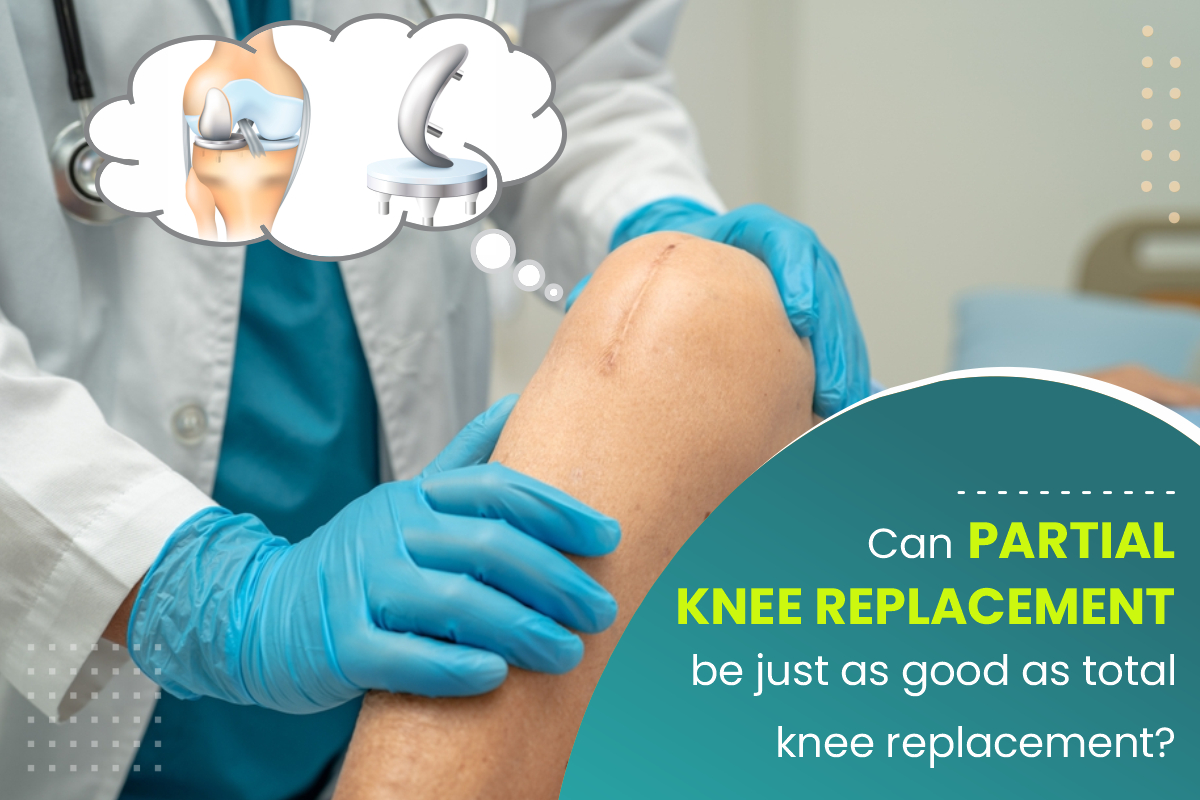Can partial knee replacement be just as good as total Knee replacement?

Partial knee replacement and total knee replacement are both surgical options for individuals with advanced knee arthritis or injury. While total knee replacement has been the standard procedure for many years, recent advancements have made partial knee replacement a viable alternative for certain patients. Are partial knee replacements just as good as total knee replacements? How do the two procedures compare in terms of success rates, recovery time, and overall patient satisfaction? These are important questions that individuals considering knee replacement surgery should ask.
In this article, we will explore the benefits and drawbacks of partial and total knee replacement and help you determine which procedure is best for you.
What is Partial Knee Replacement? What are the Benefits of Partial Knee Replacement?
Partial knee replacement, also known as uni-compartmental knee arthroplasty, is a surgical procedure that replaces only the damaged part of the knee joint, instead of the entire knee. This approach preserves healthy bone and tissue, which can lead to several benefits compared to a total knee replacement.
1. Less bone and soft tissue dissection:
One of the primary benefits of partial knee replacement is that it is a less invasive procedure than total knee replacement. Unlike a total knee replacement, which involves removing and replacing the entire knee joint with an artificial joint, a partial knee replacement only replaces the damaged part of the joint. This means that there is less need for bone and soft tissue dissection, which can lead to less trauma to the surrounding tissue, less blood loss, and a smaller incision.
2. Less blood loss:
Another benefit of partial knee replacement is that it can lead to less blood loss during surgery. Because the procedure is less invasive than a total knee replacement, there is less trauma to the surrounding tissue, which can help reduce the risk of bleeding.
3. Fewer complications:
Partial knee replacement surgery is generally associated with fewer complications than total knee replacement. Because the procedure is less invasive, there is a lower risk of complications such as infection, blood clots, and nerve damage. In addition, partial knee replacement patients often experience a shorter hospital stay and a faster recovery time than those who undergo total knee replacement.
4. Faster recovery of range of motion:
Another of the benefits of partial knee replacement is that patients may be able to regain range of motion more quickly than with total knee replacement. This is because the procedure is less invasive and involves less trauma to the surrounding tissue. In addition, partial knee replacement surgery patients may experience less pain and swelling than those who undergo total knee replacement, which can also help speed up the recovery process.
5. Better range of motion overall:
Finally, partial knee replacement may provide a better overall range of motion than total knee replacement. Because the procedure only replaces the damaged part of the knee joint, patients may be able to maintain more of their natural knee function. In addition, partial knee replacement patients may experience less pain and stiffness than those who undergo total knee replacement, which can lead to improved mobility and a better quality of life.
Who qualifies for Partial Knee Replacement?
A good candidate for partial knee replacement is typically someone who experiences knee pain and stiffness, mainly when walking or climbing stairs, which has not responded to non-surgical treatments such as medication, physical therapy, or cortisone injections. The patient should also have good bone quality and range of motion, and should not have severe deformity or instability in the affected knee.
Additionally, the patient should be in good overall health and not have any underlying medical conditions that would make surgery risky, such as heart disease, lung disease, or a history of blood clots. Age is not necessarily a factor in determining candidacy for this surgery, as it can be performed on both older and younger patients.
As with any surgery, it is important for the patient to have realistic expectations for the outcome of the procedure and to be committed to the rehabilitation process after surgery in order to achieve the best possible outcome. A consultation with an experienced orthopaedic surgeon can help determine if partial knee replacement surgery is the right option for a particular patient.
What is total knee replacement? Why partial knee replacement can be chosen over total knee replacement?

Total knee replacement surgery is a medical procedure where a damaged or arthritic knee joint is replaced with an artificial joint made of metal and plastic components. This surgery is typically recommended for patients who suffer from severe knee pain, stiffness, and limited mobility that cannot be relieved with non-surgical treatments.
Why partial knee replacement over total knee replacement? Because it has several advantages.
— Firstly, it is a less invasive surgery with a smaller incision, which can result in less pain, less blood loss, and a shorter recovery time.
— Additionally, benefits of partial knee replacement include a lower risk of complications such as infection, blood clots, and nerve damage.
— Furthermore, partial knee replacement can also result in a more natural feeling knee, as the healthy parts of the joint are preserved, leading to a better range of motion and increased mobility.
— Patients who undergo partial knee replacement surgery typically experience a quicker return to their normal activities compared to those who undergo total knee replacement.
In conclusion, both total knee replacement and partial knee replacement are viable options for patients suffering from knee arthritis or joint damage. Ultimately, the decision to undergo partial knee replacement versus total knee replacement should be made in consultation with a qualified orthopaedic surgeon. The surgeon will assess the patient’s condition, and recommend the best course of action based on the individual’s unique situation. With proper care and follow-up, both total knee replacement and partial knee replacement can provide significant pain relief and improved mobility for patients.






